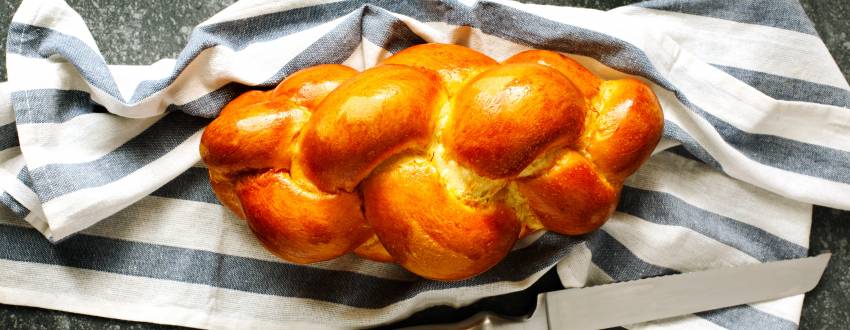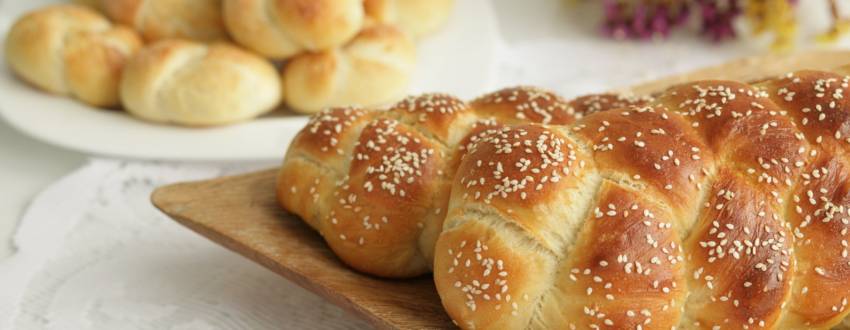Shailoh of the Week by Rabbi Zvi Nussbaum
Rabbinic Coordinator, Kosher Hotline Administrator for the Orthodox Union
We are all familiar with the mitzvah of hafrashat challah. When baking large amounts of bread, cake, or cookies, we make a berachah and take off a small piece of dough as the challah. Many bake extra dough in order to be able to perform this special mitzvah.
Special, intricate systems have been set up, under the guidance of our poskim, to help perform this mitzvah properly in large (Jewish owned) industrial bakeries. Nevertheless, it is helpful to review the details of separating and disposing of challah as it pertains to its performance in homes and bakeries.

Which items require Hafrashas Challah? If one bakes bread, cake, crackers, or cookies with flour from the five grains, one must separate challah. This is true whether one prepares a thick or a thin (pourable) dough. It is generally assumed that the five grains are wheat, barley, oats, spelt, and rye. If one bakes with other grains, there is no obligation to separate challah.
How much do I have to bake? If one bakes with the volume of 43 1/5 beitzim of flour, one must be mafrish (separate) challah. There is a difference of opinion when translating this amount into contemporary terms. According to some opinions, one is obligated to separate challah when kneading dough that contains more than 2 2/3 pounds of flour. Others have the practice to separate challah only if the dough is made with close to four pounds of flour. However, the common practice is to recite a beracha only if five pounds of flour is used in the dough.

When is the hafrasha done? When baking bread or a cake with a thick dough, one should separate challah after kneading the dough but before the bread is baked. However when baking a cake with a batter that can be poured, the challah is separated after the cake is baked.
How is it done? One breaks off a small piece (approximately a kezayit) recites the beracha בא“ה אמ“ה אשר קדשנו במצוותיו וציונו להפריש חלה or להפריש תרומה, then verbally declare harei zu trumah or harei zu challah.
When separating challah for several batches of dough at one time (when each one contains the shiur challah), all of the dough should be in close proximity to each other at the time of the declaration. If the dough is not in a bowl or container, it is sufficient for all of the dough to be in the same room as the person who is separating the challah. However, if the batches of dough are in bowls or containers, one should be careful (לכתחילה) that while separating the challah the bowls should be open and touching.
However, if one or all of the containers does not contain the shiur challah, this method does not suffice. In such a situation, one should place all of the dough into one large container before separating challah. Similarly, if one bakes several small batches of bread or cake and then puts them all together in a bag, container, or freezer, one must separate challah if the combined batches make up a shiur challah. For example, if one baked cookies in three separate batches with each batch containing two pounds of flour and he then placed all of the cookies into a cookie jar, one must separate challah from the cookies.

What do I do with the “challah”? The Torah (Bamidbar 15:21) says that the challah is given as a present to a kohain to eat. However, since we are all tamei nowadays, the kohanim can no longer eat the challah. The halacha is that terumah and challah that are tamei must be burnt.
Preferably, one should put the challah into an open fire until it is completely burnt. The Rema records the practice of burning the challah in the fire inside the oven before baking bread. Since this is not very practical in modern ovens, one possible alternative is to place the small piece of dough in the middle of a burner on a gas stove top for a few minutes until it is burnt to a crisp. It goes without saying that care must be taken to avoid any possibility of a fire.

Alternatively, one can place the piece of dough into the oven until it is completely burnt. When doing so, it is important to keep in mind a few important points. It is best to burn the challah in the oven uncovered in order to make sure that the challah is completely burnt. However, since the challah is not permitted to be eaten by a non-kohain (or by a kohain who is tamei), we cannot allow any of the taste of the challah to come in contact with the food that we eat. As such, one should not place it directly on the broiler where one broils livers or on the oven rack. Rather, one should place the challah on a dedicated “challah burning” tray or on a piece of aluminum foil and leave it in the oven until it is completely burnt. Some wrap the challah dough in a piece of aluminum foil. The disadvantage of doing so is that it will take a very long time for the dough to be properly burnt.
May I use my oven while the “challah” is burning? If the challah is completely wrapped up, one may bake other items in the oven while the challah is burning. However, if the challah is uncovered, it is best to avoid baking anything else in the oven while the challah is burning. If one accidentally did use the oven while the challah was burning, one may eat the food.
Is there any other way to dispose of the “challah”? Most opinions hold that one is not permitted to destroy the challah in any other manner.16 The opinion of the Chazon Ish is that if it is too difficult to burn the challah, and by leaving it around the house one may inadvertently eat or mistreat the challah, one may bury the challah. However, many disagree and feel that the challah should always be burnt.






Reviews